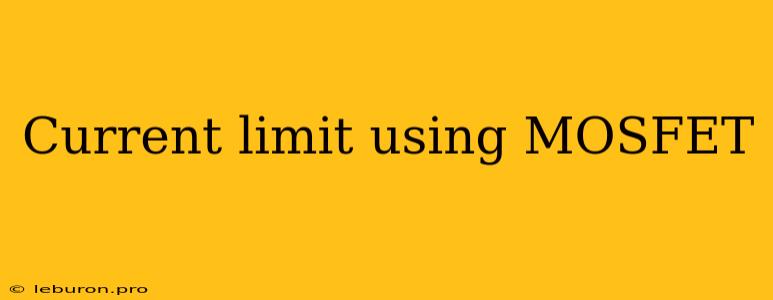Understanding Current Limit Using MOSFETs: A Comprehensive Guide
MOSFETs, or Metal-Oxide-Semiconductor Field-Effect Transistors, are ubiquitous in modern electronics, serving as versatile switching and amplification devices. One of their crucial applications lies in current limiting, a technique used to protect sensitive circuits and components from damaging overcurrents. This article delves into the intricacies of current limiting using MOSFETs, exploring its principles, design considerations, and real-world implementations.
H2: The Fundamentals of MOSFET Operation
Before diving into current limiting, it's essential to understand the fundamental operation of MOSFETs. They act as controlled switches, allowing current to flow between their drain and source terminals when a voltage is applied to their gate terminal. This voltage creates an electric field that controls the conductivity of a channel within the MOSFET. The higher the gate voltage, the higher the conductivity, and the more current can flow.
H2: How MOSFETs Achieve Current Limiting
Current limiting with MOSFETs revolves around exploiting their inherent characteristics:
H3: 1. Series Connection: In this configuration, the MOSFET is placed in series with the load that needs protection. When the current through the MOSFET exceeds a predetermined limit, the gate voltage is adjusted to decrease the MOSFET's conductivity. This effectively throttles the current flow, protecting the load from damage.
H3: 2. Sensing Resistor: A small resistor is placed in series with the load, and its voltage drop is monitored. This voltage drop is proportional to the current flowing through the load. If the voltage drop exceeds a set threshold, the MOSFET's gate voltage is manipulated to limit the current.
H3: 3. Feedback Control: More sophisticated current limiting circuits employ feedback control loops. A sensing circuit monitors the load current and feeds it back to the gate of the MOSFET. This feedback mechanism allows for dynamic control of the MOSFET's conductivity, ensuring precise and responsive current limiting.
H2: Key Design Considerations
Implementing effective current limit using MOSFET circuits necessitates careful consideration of several factors:
H3: 1. MOSFET Selection: Choosing the right MOSFET is crucial. Its current handling capability, voltage rating, and switching speed must align with the application's requirements. For high-current applications, MOSFETs with low on-resistance are preferred to minimize power dissipation.
H3: 2. Current Limit Threshold: This parameter defines the maximum allowable current. It's crucial to set the threshold slightly higher than the expected maximum current to provide a safety margin.
H3: 3. Response Time: The speed at which the MOSFET reacts to current overshoots is critical. Fast response times are crucial in applications where rapid current transients can occur.
H4: 4. Power Dissipation: The MOSFET itself can dissipate considerable power, especially when operating at high currents. Adequate heatsinking is essential to prevent overheating and potential damage.
H2: Applications of Current Limiting Using MOSFETs
Current limit using MOSFETs finds widespread application in various electronic systems, including:
H3: 1. Power Supplies: Limiting output currents in power supplies protects both the supply and the load from overcurrent conditions.
H3: 2. Battery Chargers: Safe charging of batteries is essential, and current limit using MOSFETs ensures that the charging current remains within acceptable limits.
H3: 3. Motor Control: Controlling the current flow in electric motors optimizes their performance and prevents excessive current draw, which can damage windings.
H3: 4. LED Drivers: LEDs are sensitive to current, and current limit using MOSFETs ensures that each LED receives the correct operating current for optimal brightness and longevity.
H2: Real-World Examples
Here are some examples of current limit using MOSFET implementations:
- Basic Current Limiting Circuit: A simple circuit can be constructed using a sensing resistor, a comparator, and a MOSFET. When the voltage drop across the sensing resistor exceeds a threshold, the comparator triggers the MOSFET to limit the current.
- Overcurrent Protection in Power Supplies: A current limiting circuit can be integrated into a power supply to protect the load and the power supply itself from overcurrents.
- Motor Drive with Current Limiting: A motor drive circuit can incorporate current limit using MOSFETs to control the motor's current and prevent it from drawing excessive current during startup or under heavy load.
H2: Advantages of Current Limiting Using MOSFETs
Current limit using MOSFETs offers several advantages:
- Efficiency: MOSFETs typically exhibit low on-resistance, minimizing power losses during current limiting.
- Versatility: MOSFETs can be tailored to various applications by selecting appropriate types with different current ratings and switching speeds.
- Cost-effectiveness: MOSFETs are generally affordable, making them a practical solution for current limiting.
H2: Conclusion
Current limit using MOSFETs is a versatile technique employed to protect sensitive circuits and components from harmful overcurrents. Understanding the principles of MOSFET operation and considering key design factors are essential for implementing effective current limiting solutions. MOSFETs' versatility, efficiency, and cost-effectiveness make them an ideal choice for a wide range of applications where current protection is critical. Whether it's in power supplies, battery chargers, motor control, or LED drivers, current limit using MOSFETs ensures reliable and safe operation for electronic systems.
